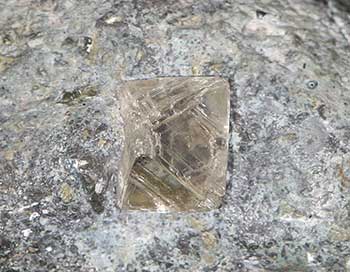 |
| Diamond in Kimberlite - C. |
What is a Diamond?
A Diamond is the hardest rock known to man. It's name means unbreakable or invincible. Although it is composed of simple carbon atoms, the same as coal or graphite, the unique qualities of diamonds make them one of the most valued substances on earth. Although graphite has stronger molecular bonds, the molecules are arranged in flat sheets making graphite a very brittle rock. Diamonds, however, have a three-dimensional molecular structure that makes it very difficult to introduce impurities or scratch. A diamond ranks a 10 on the Moh's hardness scale making the hardest known substance and can only be scratched by other diamonds. Diamonds are valued primarily for their hardness and thermal conductivity, however, they are also prized for their luster formed from their ability to disperse light like a prism. Most diamonds are without color although a small percentage can be brown, yellow, red, pink, blue, among other colors. These colors are formed from small traces of other elements mixed with the diamond. These elements are few and far between due to a diamonds molecular structure. Nitrogen, for example, creates a yellowish hue and is found in yellow and brown diamonds. Large pure diamonds are rare and highly valued. About 80% of all diamonds are too small or otherwise impure making them unfit for gemstones and better suited for industrial use. Diamonds are measured in carats which is equal to one fifth of a gram.
Where are Diamonds found?
Most natural diamonds are found in kimberlites or lamproites, structures of igneous rock created during volcanic activity. Sometimes these diamonds can be carried elsewhere when water and erosion wash them away. These are called placer deposits. Small diamonds can also be found on a very small scale in some large meteor impacts. In addition to these sources, diamonds can also be produced artificially although only a small percentage of diamonds are synthetic. Diamonds are found in over 35 countries, including the United States, Australia, Brazil, China, Russia, and several large mines in South Africa.
What are Diamonds used for?
The first recorded use of diamonds was in India as religious objects as well as engraving tools. Today diamonds are extremely useful but its uses are few. They are known particularly for their use in jewelry, such as rings or necklaces, because of their durability and their luster. However, most diamonds are used industrially. Because of their hardness, diamonds are extremely useful when used to cut, grind, or drill other materials. Therefore, many cutting blades or drills have small diamonds included on the tips and edges.
How are Diamonds made
Diamonds are made in the earth, generally in the upper mantle. Diamonds are made of carbon just as coal and graphite are, but are put under high pressure and heat to give them the molecular structure that they have. This process can take up to 1-3 billion years to form naturally. They are then brought close to the surface during volcanic activity. Some small diamonds can be formed in a meteorite impact that produces similar circumstances to the heat and pressure found in the mantle. Another way of forming diamonds is to do so synthetically. This is done by simulating in a controlled environment, the high-pressure/high-temperature surroundings that natural diamonds are formed in. Diamonds are hard but they are also brittle. By knowing the correct place to cut a diamond they can be cut in one blow. This is done through an extensive scientific and mathmatical process.